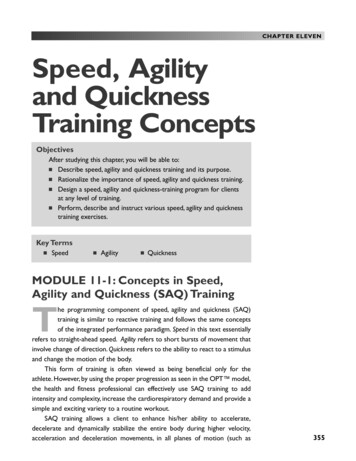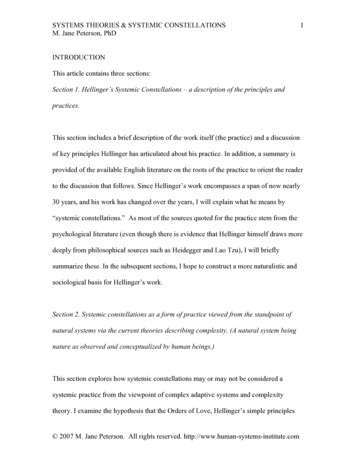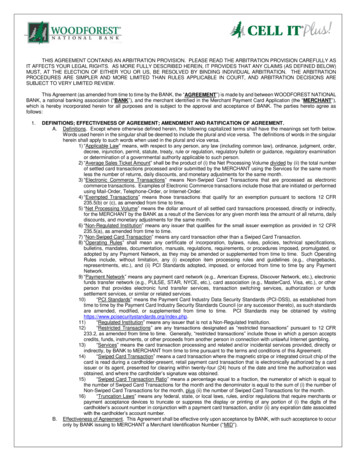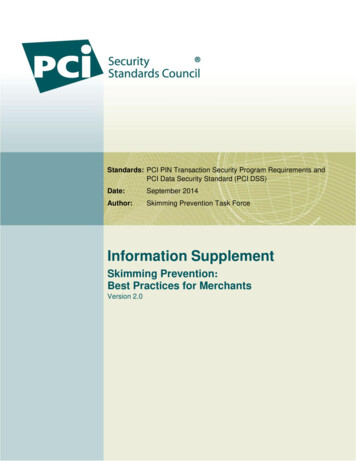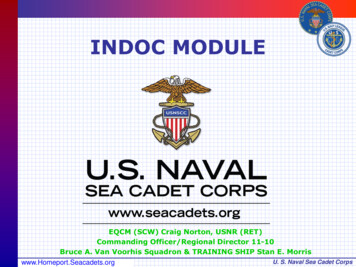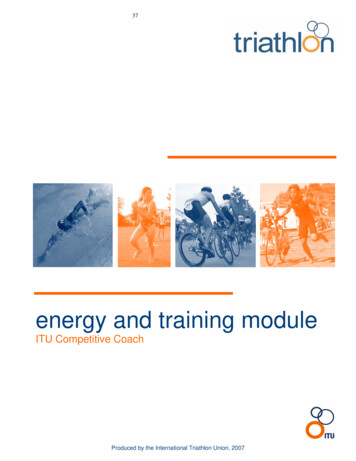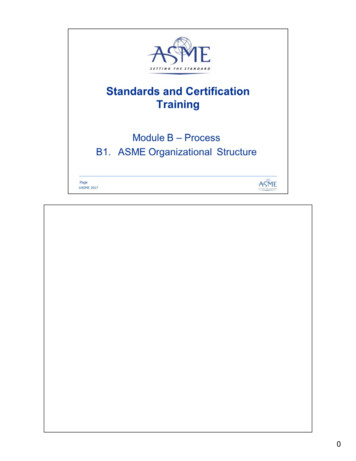
Transcription
0
1
Module B contains eleven submodules. We will start with B1 – ASME OrganizationalStructure.2
At the end of this module you will be able to: Describe the organizational structure of ASME and its sectors. Describe the organization of the Standards and Certification (S&C) Sector. Identify the types of codes, standards or conformity assessment programscovered by each of the Supervisory Boards reporting to the S&C Council. Understand the Roles of ASME Learning and Development and ASME ST-LLCwithin the S&C Sector.3
The Society’s Mission Statement is “to serve our diverse global communities by advancing,disseminating, and applying engineering knowledge for improving the quality of life; andcommunicating the excitement of engineering.” ASME aims to be the essential resource formechanical engineers and other technical professionals throughout the world for solutionsthat benefit humankind.In order to achieve this mission, five core technologies have been identified in which ASMEwill deliver locally relevant engineering to advance: Manufacturing – Both traditional industrial production and emerging areas includingAdditive/3D and Digital Manufacturing. Pressure Technology – Technologies involved in the design, analysis, materials,fabrication, construction, inspection, operation, nondestructive evaluation, and failureprevention of pressure vessels, piping, pipelines, power and heating boilers, heatexchangers, reactor vessels, pumps, valves, and other pressure and temperaturebearing components. Robotics – Traditional industrial machine systems that typically have three degrees ormore of articulation as well as emerging areas such as drones and autonomousvehicles. Clean Energy – Technologies to support the generation of electric power whileminimizing environmental impact. Bioengineering- The applications of engineering skills and analysis to the developmentof pharmaceuticals, biological devices, food supplements, and other products.4
At the top of ASME’s organizational structure is the Board of Governors.Reporting to the Board of Governors are four groups called “Sectors.” These are: Standards and Certification, Technical Events and Content, Public Affairs and Outreach and Student and Early Career Development.Each of these Sectors has responsibility for a specific area and carries out activitiesdesigned to further the objectives of the society.Let us briefly take a look at the responsibilities of the Board and each of the Sectors,starting with the Board of Governors.5
The Board of Governors is responsible for developing the overall policy for the Society anddelegating responsibility to subsidiary bodies including Subordinate Committees andSectors to ensure fulfillment of ASME’s Mission and Vision.The Board of Governors is made up of twelve voting members and the Executive Directorof the Society, who is a non-voting member.6
The Public Affairs and Outreach Sector is responsible for the coordinated outreach toindustry, government, education, and the public as well as initiatives that address diversityand humanitarian programs.The Public Affairs and Outreach Sector is led by a council which currently has the followingBoard and Committees reporting to it: Industry Advisory Board Committee on Government Relations Engineering for Global Development Committee Committee on Engineering Education Pre-College Education Committee Diversity & Industry Strategy Committee7
The underlying purpose of ASME’s Technical Events and Content Sector is to provide afocused arena for business activities relevant to identified technical, educational ortechnological endeavors.The Technical Events and Content Sector currently has five segments: Design, Materials, and Manufacturing Segment (DMM) Energy Sources and Processing Segment (ESP) Energy Conversion and Storage Segment (ECS) Gas Turbine Segment (GTS) Engineering Sciences Segment (ESS)8
The Student & Early Career Development Sector’s mission is to provide a voice forstudents and early career engineers. This Sector will provide advocacy leadership andcreate opportunities for students and early career engineers to influence the “path forward”for ASME.The Student and Early Career Development Sector is led by a council which currently hasthe following Committees reporting to it: Early Career Engineer Programming Committee Student Programming Committee9
The issue of standards was discussed at the very first ASME meeting in 1880 with the topicbeing standardized sizes for screw threads. For over 125 years, ASME Standards andCertification has continually strived to develop the best, most applicable codes, standards,and conformity assessment programs in the world for the benefit of humanity.The S&C Mission is to involve the best and the brightest people from all around the world todevelop, maintain, and promote the use of these ASME products and services.10
To date, ASME currently has over 500 codes and standards in print. Standards andCertification committee activities involve about 5,500 individuals, mostly volunteers, ofwhich over 1,100 of these individuals reside outside the U.S. Not all active individuals areASME members, though membership in ASME is encouraged.ASME standards are used in over 100 countries around the world.Finally, ASME has certified manufacturers of products related to ASME codes andstandards in approximately 75 countries.11
There are nine Boards that report to the Council on Standards and Certification. FiveSupervisory Boards and the four advisory Boards shown in grey.The membership on the Council and the responsibilities of these Boards will be discussedbriefly in the next several slides.12
The Chair and two Vice Chairs of the Standard & Certification Council are appointed by the Boardof Governors. The Chair of the Council is also known as the Senior Vice President, Standards andCertification The Vice Chair of Operations who will also serve as the Chair of the Board on Codesand Standards Operations (BCO) The Vice Chair of Strategic Initiatives who will also serve as the Chair of the Board onStrategic Initiatives13
Council Membership Includes: The Chairs of all Supervisory Boards The Chair of the Board on Hearings and Appeals The Chair of the Energy and Environmental Standards Advisory Board (EESAB) Twelve members-at-large Associate Executive Director, Standards and Certification (non-voting) Managing Directors, S&C (non-voting)14
The Advisory Groups are primarily forums for discussion of issues associated with standardsdevelopment. They are tasked with making recommendations for Council on Standards andCertification action in their respective areas and taking action on items delegated by the Council onStandards and Certification. The Board on Codes and Standards Operations deals with honors, informational services, legalconsiderations, procedures and planning; considers action on items delegated by Council onStandards and Certification (e.g., standards committee charters, procedures, personnel). The Board on Hearings and Appeals provides a forum for appeals resulting from allegedgrievances related to procedural due process in codes, standards and related conformityassessment programs. The Board will first evaluate the validity of the alleged grievance todetermine whether a hearing should be scheduled. The Energy and Environmental Standards Advisory Board coordinates initiation of newstandards development, workforce development, certification programs and related productsand services addressing global energy and environmental needs. The Board on Strategic Initiatives advises the Council on Standards and Certification on trends,implications, strategic issues and planning.15
The Supervisory Boards are responsible for creating and supervising the committees that developnew and revised standards. Each Board is specifically responsible for: Assessing the need for S&C activity Structuring the necessary committees Ensuring procedures for due process Approving and discharging committee personnel Approving codes and standards for ASME Hearing appeals Recommending the disbanding of a committeeEach Supervisory Board presides over Standards and Certification activities which focus on aparticular area of interest. The areas covered by each of the five supervisory Boards will bedescribed in the following slides.16
The areas of responsibility for the Board on Standardization and Testing includes management andsupervision of the dimensional, design, application, drafting and other standards, as well thedetermination of performance of mechanical equipment designed to meet specified criteria ofperformance and operability (also known as performance test codes).Examples of some of the standards developed under this Board are: A112.19.7M, Whirlpool Bathtub Appliances B18.1.1, Small Solid Rivets EA-2, Energy Assessment for Pumping Systems PTC 19.1, Test Uncertainty, PTC 46, Overall Plant Performance V&V 20, Verification and Validation in Computational Fluid Dynamics and Heat Transfer Y14.5M, Dimensioning and Tolerancing17
Safety Codes and Standards address the safety of employees and the public in the construction,installation, operation, inspection and maintenance of cranes, elevators, escalators and similarequipment.Examples of some of the standards developed under this Board are: A17.1, Safety Code for Elevators and Escalators B30.5, Safety Standard for Mobile and Locomotive Cranes CSD-1, Safety Standard for Controls and Safety Devices for Automatically Fired Boilers RT-2, Safety Standard for Structural Requirements for Heavy Rail Transit Vehicles18
Pressure Technology covers rules governing the design, fabrication and inspection of nonnuclear pressure-containing equipment.Examples of some of the standards developed under this Board are: B16.5, Pipe Flanges and Flanged Fittings B31.1, Power Piping BPE, Bioprocessing Equipment BPVC Section I, Rules for Construction of Power Boilers BPVC Section VIII, Rules for Construction of Pressure Vessels (Div. 1, 2 and 3) RTP-1, Reinforced Thermoset Plastic Corrosion-Resistant Equipment19
Nuclear Codes & Standards covers standards for nuclear facilities and technology.Examples of some of the standards developed under this Board are: BPVC Section III, Rules for Construction of Nuclear Facility Components BPVC- XI, Rules for Inspection of Nuclear Power Plant Components NQA-1, Quality Assurance Requirements for Nuclear Facility Applications OM, Code for the Operation and Maintenance of Nuclear Power Plants20
The main role of the Board on Conformity Assessment is to oversee the operation ofaccreditation, product certification, personnel certification, and management system certificationprograms established by standards committees under the jurisdiction of other SupervisoryBoards.Examples of these programs include, but are not limited to: The accreditation of Authorized Inspection Agencies, Product certification for Boilers and Pressure Vessel components and Nuclear Components, Personnel certification for Geometric Dimensioning and Tolerancing Professionals, and Management system certification for Bioprocessing Equipment.21
Examples of some of the standards developed under this Board are: CA-1, Conformity Assessment Requirements QAI-1, Qualifications for Authorized Inspection QRO-1, Standard for the Qualification and Certification of Resource Recovery FacilityOperators22
Each Supervisory Board has numerous of standards committees that reports directly tothem. The Standards committee is a group of technically qualified experts that areresponsible for developing consensus on proposed standards actions. However, in manycases, the standard development activities is delegated to one or more SubordinateGroups.23
Each Standards Committee may have a number of subordinate groups that reports to them.These groups: Develop specific proposals for the committee’s formal consensus consideration. May draw on the expertise of individuals who may not be members of the Standardscommittee. This enables the Standards committee to access expertise unencumberedby requirements of formal membership which may not be possible for all interestedindividuals. Subordinate group names vary by Committee and can include Project Teams,Subcommittees, Task Groups, Working Groups and Ad-hoc Groups.24
The S&C Committee standards action development process typically proceeds in a tieredfashion: The Subordinate Group develops a formal proposal. Technical discussion may occur in related Standards committees, subordinate groups,or with others with necessary expertise. Once the proposal is approved by the Subordinate Group(s), it proceeds to theStandards Committee, who then votes on the proposal to achieve consensus. Once consensus has been achieved by the Standards Committee, the appropriateSupervisory Board certifies that the procedures have been followed throughout theproposal development and voting process and that the procedural requirements havebeen met.Further details into the consensus process for S&C activities are discussed in Modules B5,Consensus Process for Standards Development and/or B9, ASME Conformity AssessmentPrograms.25
ASME Learning and Development maintains close relationship with ASME S&C to providecompanion courses for codes and standards where there is a need.Course Formats include: Online ASME Assessment Based Courses In-Company Training On-line instructor – supported courses Instructor-led courses on various topics world-wideASME Learning and Development Catalog can be found at this web-site address.26
The ASME Standards Technology, LLC (ST-LLC) is a not-for-profit Limited Liability Company,with ASME as its sole member.The ambition of the ASME ST-LLC is to meet the needs of industry and government byproviding new standards-related products and services, which advance the application ofemerging and newly commerc
We will start with B1 –ASME Organizational Structure. 2. At the end of this module you will be able to: Describe the organizational structure of ASME and its sectors. Describe the organization of the Standards and Certification (S&C) Sector. Identify the types of codes, standards or conformity assessment programs covered by each of the Supervisory Boards reporting to the S&C Council .
